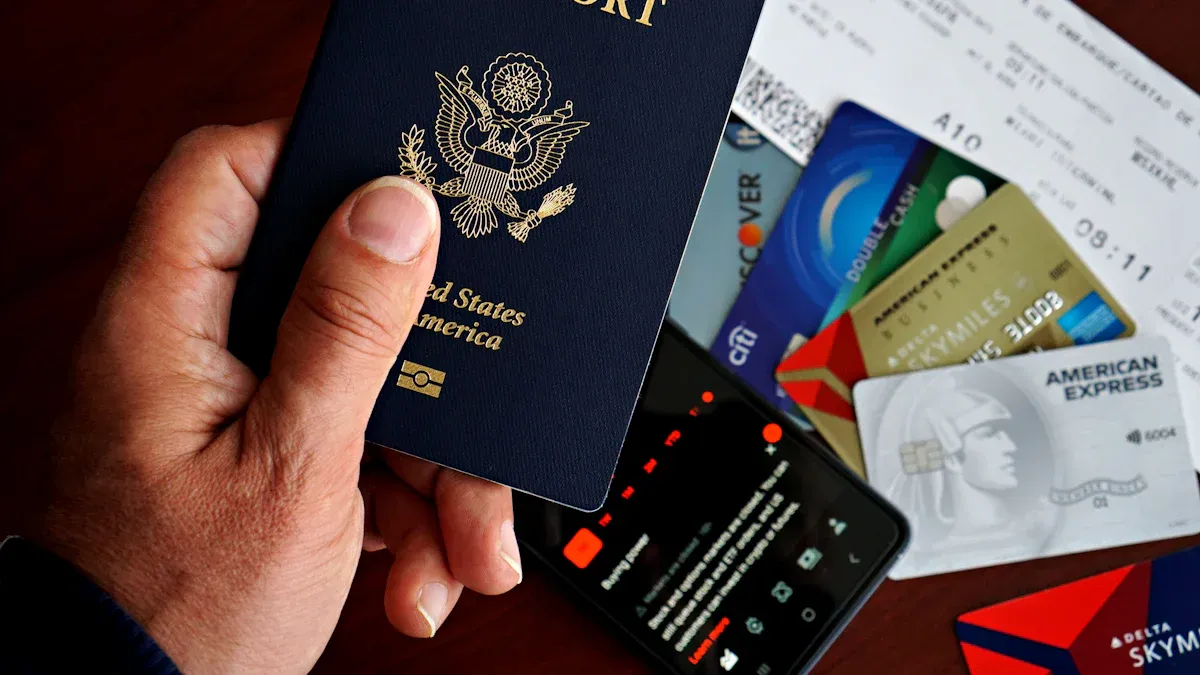- EasyCard
- Trade
- Help
- Announcement
- Academy
- SWIFT Code
- Iban Number
- Referral
- Customer Service
- Blog
- Creator
Must-Read for Businesses: How to Choose the Optimal Real-Time Cross-Border Payment Solution

Image Source: pexels
The B2B e-commerce market size is expected to reach $20.9 trillion by the end of 2024. In global competition, efficient and low-cost payment capabilities are a key advantage for businesses. Choosing the right real-time cross-border payment solution can significantly improve capital turnover efficiency and profitability. Therefore, businesses must first clearly identify their most urgent business needs—whether to pursue the lowest cost or the fastest speed.
Core Points
- When choosing a cross-border payment solution, businesses should first clarify their own needs, such as wanting to save money or have funds arrive faster.
- The total cost of cross-border payments is not just the transfer fee; exchange rate spreads are often the largest hidden cost.
- Third-party payment platforms are usually cheaper and faster than traditional banks because they directly connect to local payment systems.
- Intelligent payment systems can automatically select the best payment method, helping businesses save money and improve efficiency.
- There is no payment solution that fits all businesses; companies need to choose the most suitable combination based on their own situation.
Step One: Diagnose Your Core Business Needs
The prerequisite for choosing the optimal solution is a clear understanding of your own needs. Businesses should examine the pain points of their current operations and future development directions from the four basic dimensions of cost, efficiency, security, and coverage.
Cost-Oriented: How to Reduce Total Transaction Fees
The total cost of cross-border payments is far more than a fixed transfer fee. It consists of multiple parts, including explicit fees and often overlooked hidden costs. Businesses must comprehensively evaluate these fees to effectively control costs.
Fee Structure Breakdown The total cost of international payments usually includes the following items:
- Fixed Transfer Fee: A per-transaction service fee charged by the bank or service provider, which may range from 0 to about $45.
- FX Markup: This is the main hidden cost. The difference between the exchange rate provided by the service provider and the real market mid-rate, usually 0.5% to over 3%. For a $60,000 transaction, a 2.5% FX markup means $1,500 in additional costs.
- Intermediary Bank Fees: In traditional wire transfer paths, each correspondent bank may charge $15 to $50.
The table below shows the typical fee ranges for different payment channels:
| Payment Method | Fee Range/Average Fee |
|---|---|
| Bank Transfer | 4% to 15% |
| Money Transfer Operators | Average 6.5% |
| FX Brokers | 3-4% lower than banks |
Efficiency Priority: How to Achieve Real-Time Fund Arrival
Fund turnover speed directly affects the health of a company’s cash flow. Traditional international wire transfers usually take 1 to 5 business days to complete settlement, which is already lagging in a fast-paced business environment. Businesses pursuing high efficiency should prioritize solutions that can provide near real-time arrival capabilities. For example, Europe’s SEPA network and the US Fedwire system can achieve fast payments within their coverage areas. Modern real-time cross-border payment services, by integrating these local clearing networks, can shorten transaction times to minutes.
Security and Compliance: How to Ensure Fund and Data Security
As transactions move online, the importance of payment security and compliance is increasingly prominent. Businesses face multiple risks such as phishing, malware attacks, and fake invoice fraud. At the same time, regulatory requirements in different countries and regions vary greatly, such as the EU’s General Data Protection Regulation (GDPR) and the Financial Action Task Force (FATF) anti-money laundering standards. Therefore, when choosing a payment service provider, businesses must confirm that it has strong risk control capabilities and industry security certifications, such as PCI DSS (Payment Card Industry Data Security Standard) or SOC 2 certification, to ensure that funds and sensitive data are properly protected.
Global Coverage: How to Reach Emerging and Specific Markets
The expansion of business territory requires the payment network to have corresponding coverage capabilities. If a company’s target markets are emerging economies such as Brazil or India, it needs a solution that can access their local mainstream payment systems. For example, Brazil’s Pix and India’s UPI systems have become the main payment methods locally. A solution that cannot support these localized payment tools may put the company at a competitive disadvantage in the market. Therefore, evaluating the breadth and depth of a payment solution’s global network coverage is crucial.
Step Two: Evaluate Mainstream Real-Time Cross-Border Payment Solutions

Image Source: unsplash
After clarifying core business needs, the next step is to deeply understand and evaluate the mainstream payment solutions on the market. Each solution has its unique technical path and applicable scenarios. Businesses need to systematically compare them around the four dimensions of cost, speed, security, and coverage to find the choice that best matches their strategy.
Traditional Path: The Current State and Challenges of SWIFT gpi
For a long time, the SWIFT (Society for Worldwide Interbank Financial Telecommunication) network has been the backbone of international payments. However, traditional SWIFT wire transfers have been criticized for their opaque processes, slow speed, and high fees. To address these challenges, SWIFT launched the gpi (Global Payments Innovation) service, bringing significant improvements.
Core Improvements of SWIFT gpi
- Speed Improvement: Payments within the gpi network can mostly be completed within hours, and the fastest can take just minutes, far exceeding the days required for traditional wire transfers.
- End-to-End Tracking: Each gpi transaction is assigned a unique end-to-end transaction reference number (UETR), allowing payers and payees to track the fund location in real time, just like tracking a package.
- Fee Transparency: Banks participating in gpi must clearly list the fees for each transaction, including those charged by intermediary banks, improving cost predictability.
Although SWIFT gpi has made great progress, it has not completely overturned the traditional model. It is essentially an optimization of the existing correspondent banking model rather than a reconstruction. Therefore, fund flows still rely on the intermediary bank chain, which means intermediary bank fees (usually $15 to $50 per bank) still exist, and settlement speed is still limited by each bank’s processing time and holidays. For businesses pursuing ultimate efficiency and cost control, gpi may only be a transitional choice.
Third-Party Platforms: Flexibility and Cost Advantages
Third-party payment platforms (or fintech companies) are an important force that has risen in recent years. Through technological innovation, they provide businesses with more flexible and cost-effective solutions than traditional banks. The core advantage of these platforms lies in their innovative business models: by establishing local fund accounts worldwide and directly accessing local clearing networks (such as Europe’s SEPA and China’s CIPS), they bypass the SWIFT correspondent bank chain.
Taking the modern payment platform Biyapay as an example, it builds a unified payment network by integrating multiple local payment systems globally. When a business needs to pay a German supplier, funds can be paid directly to the counterparty from Biyapay’s local account through the SEPA network, with transactions usually completed in minutes and fees far lower than traditional wire transfers. This model not only greatly improves speed but also significantly reduces costs by reducing intermediate links.
The table below compares the characteristics of different types of platforms:
| Platform Type | Typical Fee Structure | Exchange Rate Policy | Core Advantages |
|---|---|---|---|
| Biyapay | Low transaction fees, no monthly fees | Offers rates close to market mid-rate | Achieves low-cost, high-speed payments by directly connecting local networks |
| Wise Business | Transparent pricing, no monthly fees | Uses market mid-rate, no markup | Supports multiple currencies, fast transfers |
| Stripe | Transparent pricing, but cross-border conversion fees may be higher | Includes currency conversion fees | Easy to integrate into e-commerce sites, supports many currencies |
| Hong Kong Licensed Banks | Higher fees, including multiple fixed fees | FX markup usually 1%-3% | Long history, high security reputation, but long processing time |
For most SMEs and businesses seeking global expansion, choosing a third-party platform like Biyapay with extensive local clearing network coverage is an ideal choice to balance cost, speed, and coverage.
Emerging Technologies: Blockchain, Stablecoins, and CBDC
Blockchain or distributed ledger technology (DLT) provides entirely new possibilities for real-time cross-border payments. It enables direct peer-to-peer value transfer between transaction participants through a decentralized shared ledger, without the need for central institution coordination.
- Core Advantages: Blockchain-based payments can achieve near-instant settlement and operate 7x24 hours without interruption. Since transaction records are tamper-proof and transparent, it also enhances payment security.
- Application Forms:
- Stablecoins: These are digital currencies pegged 1:1 to fiat currencies like the USD. They solve the price volatility problem of cryptocurrencies, making them a reliable payment medium. For example, the global payroll platform Deel has started using stablecoins to pay its contractors.
- Central Bank Digital Currencies (CBDC): Digital forms of legal tender issued by national central banks. Currently, economies representing over 98% of global GDP are exploring CBDC. China’s digital yuan (e-CNY) pilot project has reached a transaction volume of $986 billion, and multiple central banks (such as Saudi Arabia and UAE’s Aber project) are actively testing CBDC in cross-border payments.
Despite the bright prospects, these emerging technologies still face challenges. An immature regulatory environment is the biggest obstacle, although legislative attempts like the US GENIUS Act provide a regulatory framework for stablecoins, a global unified standard is far from formed. In addition, technological scalability and user acceptance need time to verify. Currently, large financial institutions like J.P. Morgan are using private blockchains for large transactions, but the technology has not yet become widespread in the B2B field.
Regional Networks: Fast Payment Solutions for Specific Markets
For businesses highly concentrated in specific regions, utilizing regional instant payment systems (IPS) is an efficient choice. These networks are built by bank alliances in specific countries or regions to facilitate instant clearing within the region.
Well-known regional networks include:
- SEPA Instant (EU): Allows payments within the eurozone to arrive in 10 seconds.
- Buna (Arab Region): Initiated by the Arab Monetary Fund to connect payment systems in the Middle East and North Africa.
- P27 (Nordics): Committed to unifying payment infrastructure in Nordic countries, supporting instant transactions in multiple currencies.
The main benefits of using these regional networks are extremely high efficiency and low costs, as they are optimized for local markets and have deep local compliance knowledge. However, their limitations are equally obvious: coverage is limited to specific regions. A business operating globally cannot rely solely on any single regional network and must treat it as a component of its global payment strategy.
Step Three: Technology Empowerment: Building Intelligent Payment Routing

Image Source: unsplash
After evaluating multiple payment solutions, businesses face a new challenge: how to dynamically select the optimal channel for each transaction? Manual comparison is neither realistic nor efficient. The answer lies in technology empowerment. Businesses can use intelligent payment routing systems to upgrade payment management from passive selection to active optimization.
What Is Intelligent Payment Routing
Intelligent payment routing is an automated decision engine. It can automatically select the payment path with the lowest cost, fastest speed, or highest success rate for each transaction based on preset rules and real-time data. Businesses no longer need to rely on a single payment service provider but can access multiple payment channels and let the system handle complex decision-making.
The “intelligence” of this system is reflected in the comprehensiveness of its decision basis. Professional payment gateway providers, such as Akurateco and Solidgate, use routing technology that comprehensively analyzes multiple dynamic variables to make judgments.
Core Data Inputs for Intelligent Routing
- Transaction Parameters: Transaction amount, currency type, recipient’s country.
- Cost Factors: Real-time exchange rates for different channels, fixed handling fees, and currency conversion costs.
- Efficiency and Stability: Historical success rates, processing speeds, and known service interruptions for each payment channel.
- Compliance Requirements: Regulatory restrictions in specific countries or regions.
By processing this data, the system can precisely direct transactions to the most suitable payment service provider or local clearing network.
How Intelligent Routing Optimizes Payment Costs and Efficiency
The core value of intelligent routing lies in achieving per-transaction cost and efficiency optimization. It helps businesses establish a diversified payment portfolio and dynamically invoke it based on real-time conditions, thereby maximizing the utilization efficiency of each fund.
The benefits brought by this technology are quantifiable. For example, by prioritizing channels with higher approval rates, a company’s overall payment success rate may increase by 11%, directly reducing customer churn and order losses due to payment failures. In terms of cost control, the system can automatically avoid channels with high FX markups or expensive fees. Cases show that businesses processing international transactions through intelligent routing can save up to 0.5% in exchange fees per transaction. For high-volume businesses, this means saving over $150,000 annually in system maintenance and transaction costs.
Ultimately, intelligent payment routing transforms complex real-time cross-border payment management into an automated, data-driven process, allowing businesses to focus on core business growth rather than spending energy on tedious payment operations.
Step Four: Build a Business-Specific Decision Matrix
After theoretical analysis and solution evaluation, businesses need a practical tool to make the final decision. Building a quantitative decision matrix can match abstract business needs with specific solution characteristics. This process helps businesses systematically and objectively select the optimal solution, avoiding judgments based solely on intuition or single information.
Use the Four-Element Matching Method for Quantitative Evaluation
The four-element matching method is a simple model that standardizes the selection process. It requires businesses to first clarify their priorities in the four dimensions of cost, speed, security, and coverage, then score each candidate solution in these dimensions, and finally calculate the weighted total score.
Operation Steps Are as Follows:
- Determine Weighting: Based on the business needs diagnosis in Step One, assign weights to the four evaluation dimensions, summing to 100%. For example, an SME highly sensitive to costs might assign 60% weight to “Cost”.
- Solution Scoring: For each candidate solution (such as SWIFT gpi, third-party platforms, regional networks, etc.), score it in each dimension (e.g., 1-5 points, 5 being optimal). Scoring should be based on the evaluation results from Step Two.
- Calculate Total Score: Multiply the “weight” by the “score” for each dimension, then sum the scores of all dimensions to get the final weighted score for each solution. The solution with the highest score is theoretically the optimal choice.
Decision Matrix Template Businesses can refer to the table below, fill in their own weights and scores, to complete the quantitative evaluation.
| Evaluation Dimension | Weight (W) | Solution A: SWIFT gpi (Score S1) | Solution B: Third-Party Platform (Score S2) | Solution C: Regional Network (Score S3) |
|---|---|---|---|---|
| Cost | For example: 40% | For example: 2 | For example: 5 | For example: 4 |
| Speed | For example: 30% | For example: 3 | For example: 5 | For example: 5 |
| Security | For example: 20% | For example: 5 | For example: 4 | For example: 4 |
| Coverage | For example: 10% | For example: 5 | For example: 4 | For example: 2 |
| Weighted Total Score | 100% | Sum of (W * S1) | Sum of (W * S2) | Sum of (W * S3) |
This matrix transforms the complex decision process into a clear mathematical problem, making the selection more scientific and transparent.
Case Study: Choices for Small and Medium Export E-Commerce
Small and medium export e-commerce is one of the most typical representatives of real-time cross-border payment needs. Their business model usually involves high-frequency, small-amount transactions and is extremely sensitive to costs and cash flow.
- Core Pain Points: Many small businesses only focus on visible “transaction fees” but fail to realize that FX spreads themselves are often the largest cost driver in cross-border payments. For e-commerce sellers, a slight adverse exchange rate change can determine whether an international expansion is profitable. In addition, traditional payment methods have long processing times, severely affecting liquidity and hindering global competitiveness. For example, in Mexico, the complexity of cross-border payments is the main obstacle preventing over 85% of SMEs from participating in export activities.
- Solution Needs: Such businesses need a payment solution with transparent pricing, fair exchange rates, and near real-time settlement. The ideal platform should provide the following functions:
- Multi-Currency Accounts: Allow businesses to receive and pay directly in local currencies, avoiding unnecessary currency conversions and exchange rate losses.
- API Integration: Seamlessly connect to the business’s ERP or e-commerce platform to automate payment processes.
- Integrated Compliance: Built-in compliance tools to help businesses easily handle regulatory requirements in different markets.
Decision Matrix Application:
For a small and medium export e-commerce, its weight distribution might be: Cost (50%), Speed (30%), Security (10%), Coverage (10%). Under this weighting, third-party platforms offering transparent exchange rates and direct local clearing network connections (such as Biyapay, Wise Business) will score much higher than SWIFT gpi or higher-fee Hong Kong licensed banks. Therefore, third-party platforms are the most reasonable choice.
Case Study: Solution Combination for Large Multinational Corporations
The payment needs of large multinational corporations (MNCs) are completely different. They face subsidiaries, suppliers, and customers worldwide, with extremely complex fund flows, and risk management is the primary task.
- Core Pain Points: Managing huge multi-currency fund pools, hedging FX risks, optimizing global liquidity, and handling complex internal fund transfers are their main challenges. A single payment channel cannot meet their diverse needs.
- Solution Strategy: The goal of large corporations is not to find a “one-size-fits-all” solution but to build a powerful payment ecosystem composed of multiple tools and strategies. They usually adopt the following advanced strategies:
- Multilateral Netting: Through an internal settlement center, offset receivables and payables between subsidiaries and settle only the net difference, thereby significantly reducing the number of actual transactions and FX costs.
- Multi-Currency Notional Pooling (MCNP): This is an advanced cash management tool that allows businesses to notionally pool funds in different currencies without actual physical conversion. This significantly reduces FX risk and optimizes internal cash flow.
- Automated Liquidity Solutions: Use technology platforms to achieve real-time visibility of global cash, ensuring optimal allocation of all available internal cash and reducing reliance on external financing.
Decision Matrix Application:
The decision matrix weights for large multinational corporations will be more balanced, even tilting toward security and coverage: Security (40%), Coverage (30%), Cost (20%), Speed (10%). Their final choice is a solution combination:
- SWIFT gpi: Used for handling large, high-value payments with major banks, ensuring the highest level of security and universal bank network coverage.
- Third-Party Platforms: Used for payments to suppliers or gig workers in emerging markets, leveraging their local network advantages to balance cost and efficiency.
- Regional Networks: Used for high-frequency transactions within specific regions such as the eurozone (SEPA) or Arab region (Buna), achieving ultimate regional efficiency.
Ultimately, large corporations achieve visibility, control, and optimization of global fund flows by integrating internal treasury management strategies and external diversified payment channels, scheduled by intelligent routing systems.
The optimal cross-border payment strategy is not choosing a single solution but the result of dynamically combining multiple payment paths. The “Diagnosis-Evaluation-Empowerment-Decision” framework provided in this article is a practical tool that can guide businesses through practice. Looking to the future, businesses should continue to pay attention to the development of global payment infrastructure.
The G20 and CPMI roadmap aims to make payments faster, cheaper, and more transparent.
The interconnection of instant payment systems (IPS) in various countries is key to achieving this goal. Only by regularly reviewing and optimizing payment strategies can businesses maintain long-term competitive advantages.
FAQ
Is There a “Universal” Optimal Solution for Cross-Border Payments?
No. The optimal solution varies with business needs. Cost-focused businesses may choose third-party platforms, while large corporations need a combination of SWIFT, third-party platforms, and other channels. Businesses should use a decision matrix to find the choice best suited to themselves.
For SMEs, What Is the Most Important Cost?
The hidden FX markup is usually the largest cost, far exceeding fixed per-transaction transfer fees. SMEs should prioritize third-party platforms that offer rates close to the market mid-rate and transparent pricing to effectively control total expenses.
Should Businesses Use Stablecoins for Payments Now?
Stablecoin payments are fast, but the global regulatory framework is not yet mature, posing compliance risks. Large institutions are testing internally, but for most businesses, it is more suitable as a technology to watch in the future rather than a current mainstream choice.
Can Businesses Without a Technical Team Use Intelligent Payment Routing?
Yes. Many modern payment platforms have built intelligent routing as a feature. Businesses do not need to develop it themselves; they only need to access the platform to automatically enjoy the cost and efficiency advantages of optimal path selection, focusing their energy on core business.
*This article is provided for general information purposes and does not constitute legal, tax or other professional advice from BiyaPay or its subsidiaries and its affiliates, and it is not intended as a substitute for obtaining advice from a financial advisor or any other professional.
We make no representations, warranties or warranties, express or implied, as to the accuracy, completeness or timeliness of the contents of this publication.




Contact Us
Company and Team
BiyaPay Products
Customer Services
BIYA GLOBAL LLC is a licensed entity registered with the U.S. Securities and Exchange Commission (SEC No.: 802-127417); a certified member of the Financial Industry Regulatory Authority (FINRA) (Central Registration Depository CRD No.: 325027); regulated by the Financial Industry Regulatory Authority (FINRA) and the U.S. Securities and Exchange Commission (SEC).
BIYA GLOBAL LLC is registered with the Financial Crimes Enforcement Network (FinCEN), an agency under the U.S. Department of the Treasury, as a Money Services Business (MSB), with registration number 31000218637349, and regulated by the Financial Crimes Enforcement Network (FinCEN).
BIYA GLOBAL LIMITED is a registered Financial Service Provider (FSP) in New Zealand, with registration number FSP1007221, and is also a registered member of the Financial Services Complaints Limited (FSCL), an independent dispute resolution scheme in New Zealand.




















